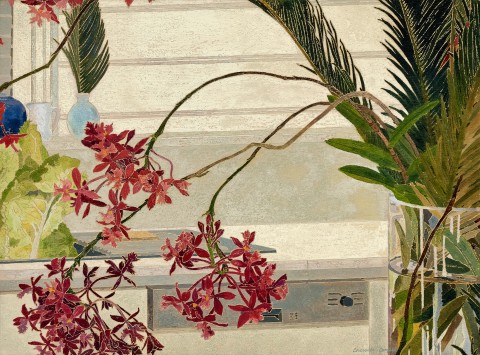CRUCIFIX ORCHIDS, 2002
CRESSIDA CAMPBELL
watercolour on incised woodblock
44.0 x 66.0 cm
signed lower right: Cressida Campbell
Nevill Keating Tollemache, London
Private collection, London, acquired from the above in 2003
Cressida Campbell: Still Lifes and Interiors, Nevill Keating Tollemache, London, 3 - 18 July 2003, cat. 13 (illus. in exhibition catalogue)
Crayford, P., (ed.), The Woodblock Painting of Cressida Campbell, Public Pictures, Sydney, 2008, cat. W0210, pp. 39 (illus.), 354
Crucifix Orchids and Lemons, 2002, woodblock print on paper, 82.0 x 60.0 cm, illus. in Crayford, P. (ed.), op. cit., p. 38
Lemons with Chinese Bowl, 2002, watercolour on incised woodblock, 38.0 x 60.0 cm, illus. in Crayford, P. (ed.), op. cit., p. 41
With a tightly cropped format containing a multitude of delicate details in form and colour, Cressida Campbell’s woodblock, Crucifix Orchids, offers a window into the serene and visually stimulating environment of the artist’s airy Bronte home. The strongest element of Cressida Campbell’s work, and that which has earned her a cult-like following in recent years, is what Christopher Allen called a ‘pervasive sense of delight in the visual world’.1 The delight that the artist finds in her everyday surroundings, the chance still life arrangements of a discarded dishcloth or the patterns of shadows on her kitchen floor, is then translated into artworks of enduring appeal.
Maintaining freshness within her slow and cumulative work, Campbell’s woodblocks and prints are constantly being re-evaluated and honed with inventiveness and ruthless rigour. Crucifix Orchids is an incised woodblock, hand-painted with watercolour paint. Campbell’s unique method of creating woodblock monoprints has been described by the artist as a ‘combination of painting and printing’.2 Created in 2002, this block was originally part of a larger, vertical composition, on a plywood sheet measuring 82 x 60 cm, called Crucifix Orchids and Lemons. This work only survives as a negative impression printed on to paper, due to the fact that the artist subsequently neatly subdivided its corresponding block into two separate horizontal compositions of 44 x 60 cm (Crucifix Orchids) and 38 x 60 cm (Lemons with Chinese Bowl). These woodblocks were later exhibited together in Still Lives and Interiors, at Nevill Keating Tollemache gallery in London in 2003, where the present owner acquired Crucifix Orchids.
Cressida Campbell has lived in her timber Victorian home in Bronte for twenty years, and the various corners of its carefully renovated white and marble kitchen have resulted in many compositions that calmly resonate with personal significance. Fans of Campbell’s works will rejoice in the cohesive continuity of her oeuvre, recognizing the recurrent themes and objects that populate her blocks and prints and connect her lived experiences to ours. While many have noted the timeless quality of Campbell’s works, the artist does not shy away from including contemporaneous items in her compositions, including here a sleekly designed modern dishwasher. Following her usual practice of flattened perspective, Campbell has ordered her picture plane into a succession of superimposed compositions: the floral arrangement of the extreme foreground, then the geometric planes of her marble topped kitchen benches in the middle-ground, followed by another miniature still life on windowsill on extending beyond the left-hand side of the composition. This sill, packed with little ceramic jugs and bowls has been the subject of a series of works in 2009 – including a long panorama woodblock of over 4 metres, called The Kitchen Shelf.
While the large cylindrical glass vase with an arrangement of palm fronds dominates the left-hand side of the block, in an arrangement that the artist revisited recently for Palm Fronds and Bowls, 2017, it’s the eponymous explosion of blossoms of the Crucifix Orchid that fixes the eye towards the centre of the block. With fragile and delicate blooms, held in clusters of cross-shaped blossoms, this species of orchid was introduced from the Caribbean but is a popular feature in coastal Sydney gardens. The late Nick Waterlow, the esteemed art historian, wrote in the introduction of Cressida Campbell’s first solo exhibition at Nevill Keating Pictures in London that her distinctive artworks ‘provide constant reminders of the unique wonders of nature in this ancient continent’ and ‘a wonderfully refreshing antidote to all those forces that want to separate us from our surrounding environment’.3
1. Allen, C., ‘Happy Days’, The Australian, 31 January 2009
2. The artist, 1985, cited in Australian Perspecta ’85, Art Gallery of New South Wales, Sydney, 1985, p. 87
3. Waterlow, N., Cressida Campbell Recent Paintings, Nevill Keating Pictures, London, 2001
LUCIE REEVES-SMITH
